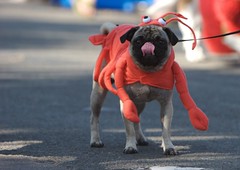This post is only obliquely about dressing dogs for parades.
Rather, it is a post about teaching and learning, albeit illustrated a bit too profusely with examples of dogs in costume.

Yesterday I had the pleasure, along with two colleagues, of speaking to around 50 university faculty from around the world on lesson planning, course development, and interactive learning.
After first describing the usefulness of concept maps in teaching and learning, we asked each faculty member to create a concept map while she developed a lesson plan on dressing dogs for parades.
Put aside any stereotypes you may have about staid professors--these faculty took to this task with vigor, arranging and rearranging sticky notes on paper and drawing connections among the notes. Faculty included concepts such as weather, dog behavior, and dog breed on their maps. They shared their maps with each other and developed their maps further.

At this point we pulled out our secret weapon: L. Dee Fink's simple concept map explaining the elements of instructional design. On this map, learning objectives (goals), learning activities, and evaluation form the three points of a triangle.
We asked the faculty to take another look at their concept maps. What were their learning objectives? What might their learning objectives be if they were teaching this dogs-in-costume lesson within their disciplines? What activities were they going to use to guide the students toward these learning objectives? And how would they know (evaluate) when their students had met these objectives?

The faculty discussed these issues among themselves and came up with some interesting learning objectives, including
- students will explore contemporary issues in animal rights and welfare
- students will learn the advantages and liabilities of textiles commonly used in pet and human fashions
- students will consider whether costuming, along with other observations they have made in their own lives, provides significant evidence that pets have replaced children as repositories of American affection in an age when real incomes are decreasing.
Among activities faculty brainstormed were:
- having students research the symbols on specific dog costumes to determine their cultural meanings and origins
- mapping the locations of dog parades in the U.S., and then overlaying the map with data on residents' educational attainment and income levels
- encouraging students to role play by assuming the perspectives of stakeholders: dog owners, dog behaviorists, dogs, animal welfare activists, local business owners, et. al.
- taking a field trip to observe a dog parade and interview participants.
Depending on the learning objectives of the course, evaluation methods might include:
- whether the dog finishes the parade wearing the entire costume
- a paper exploring Americans' cultural assumptions about and projections of race, class, gender, and sexuality vis-a-vis our pets
- an essay exam on the thought processes students used in designing costumes for their dogs.
The faculty began our lesson on course development and lesson plans by thinking solely about content: What topics do I need to cover? In what order? And how are these topics related? Many faculty came up with far more topics than could be covered in a 50-minute course period.
By the end of the workshop, faculty began to emphasize teaching and learning processes over content. It's easy--whether you are teaching a university course, an eighth-grade science class, or software training for a business client--to let yourself fall prey to what others have called "the tyranny of content." When you focus less on covering the material and more on processes of teaching and learning--and specifically on learning objectives, activities, and evaluation--you increase the quality of learning and encourage lifelong learning.
There are, of course, some fabulous edubloggers out there who write very thoughtfully about issues just like these. Here are some of my favorites:
- Artichoke
- bavatuesdays
- Gardner Writes
- Pedablogy
- Ubernoggin
- bgblogging
- Geeky Mom
- Historiann
- Ferule and Fescue
- Reassigned Time
- What Now?
On which blogs do you read good stuff about teaching and learning?
image credits: Yoda dog, superhero dogs, lobster dog, hot dog, all used under a Creative Commons license.
3 comments:
Just curious - but do you read any good edublogging from scientists? I read a lot of mentoring-blogging and general career blogging by scientists, but not a lot of classroom teaching blogging by scientists. One exception is Kim of All of My Faults are Stress Related. She's done some great blogging on teaching geology. Are there others I am missing?
Really interesting post -- thanks. As I head into this new school year, I've realized that I'm thinking more about HOW my students learn as well as WHAT they should learn, which is pushing me a good bit in the classroom. Your post and the links give me food for thought in this.
Thanks for the link, Trillwing--I'll surely be doing more posts on teaching this year now that I'm not on sabbatical (waaah! Secretly, I'm enjoying the classroom again.)
I love your comment about "the tyranny of content." I think that's the whole story of my first decade of teaching--learning to liberate myself from the 8-10 pages of lecture notes and using the classroom to emphasize connections and ways of thinking rather than as a information-delivery system. (A use for which the classroom is not so efficient!)
Post a Comment